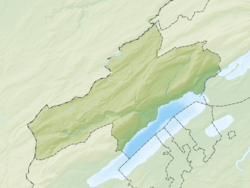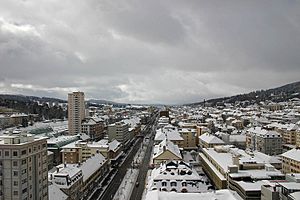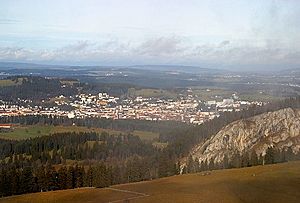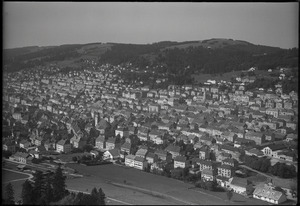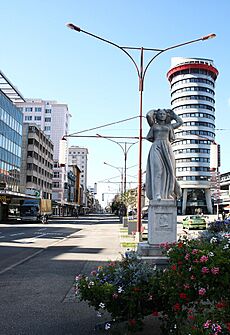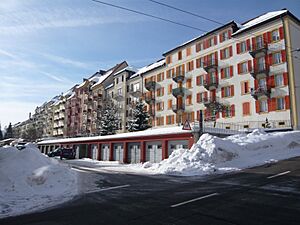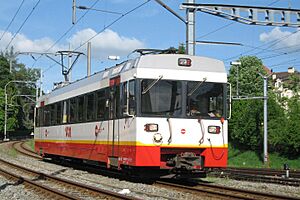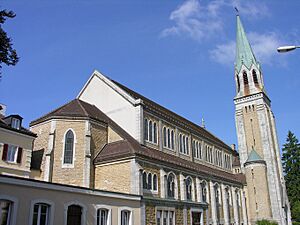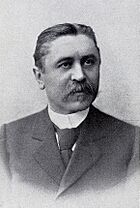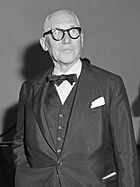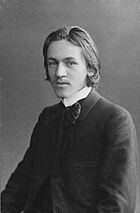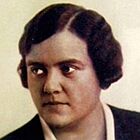La Chaux-de-Fonds facts for kids
Quick facts for kids
La Chaux-de-Fonds
|
||
|---|---|---|
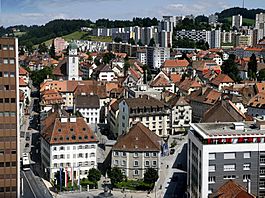
La Chaux de-Fonds in September 2005
|
||
|
||
| Country | Switzerland | |
| Canton | Neuchâtel | |
| Area | ||
| • Total | 55.71 km2 (21.51 sq mi) | |
| Elevation | 992 m (3,255 ft) | |
| Population
(Dec 2020 )
|
||
| • Total | 36,915 | |
| • Density | 662.63/km2 (1,716.20/sq mi) | |
| Postal code |
2300
|
|
| Surrounded by | Fontaines, Fournet-Blancheroche (FR-25), Grand'Combe-des-Bois (FR-25), La Ferrière (BE), La Sagne, Le Locle, Les Bois (JU), Les Fontenelles (FR-25), Les Hauts-Geneveys, Les Planchettes, Renan (BE) | |
| Twin towns | Winterthur (Switzerland), Frameries (Belgium) | |
| UNESCO World Heritage Site | |
|---|---|
| Part of | La Chaux-de-Fonds / Le Locle, Watchmaking Town Planning |
| Criteria | Cultural: (iv) |
| Inscription | 2009 (33rd Session) |
| Area | 213.7 ha (528 acres) |
| Buffer zone | 2,867.5 ha (7,086 acres) |
La Chaux-de-Fonds (pronounced la show-duh-fon) is a city in Switzerland. It is located in the Jura Mountains, close to the French border. The city sits at an altitude of 992 meters (about 3,255 feet).
It is the fifth-largest city in Romandie, which is the French-speaking part of Switzerland. As of December 2013, about 38,694 people live there.
La Chaux-de-Fonds was founded in 1656. Its growth is closely linked to the watchmaking industry. It is a very important center for making watches in an area called the Watch Valley.
In 1794, a big fire destroyed most of the city. When it was rebuilt, the city was given a special grid street plan. This plan is unique for Swiss cities. Famous people like architect Le Corbusier and carmaker Louis Chevrolet were born here. The city is also known for its Art Nouveau style.
In 2009, La Chaux-de-Fonds and its nearby city, Le Locle, were named a UNESCO World Heritage site. This means they are very important places for everyone to protect.
Contents
- Discovering La Chaux-de-Fonds: A UNESCO World Heritage Site
- A Look Back: History of La Chaux-de-Fonds
- Where is La Chaux-de-Fonds? Geography and Landscape
- City Symbol: The Coat of Arms
- Who Lives Here? Demographics
- Population Over Time: Historical Data
- Important Buildings: Heritage Sites
- How the City Works: Economy
- Beliefs and Communities: Religion
- Learning and Schools: Education
- Arts and Traditions: Culture
- Getting Around: Transport
- Weather in La Chaux-de-Fonds: Climate
- Famous People from La Chaux-de-Fonds
- Famous Watch Companies from La Chaux-de-Fonds
- Sister City: Twin Town
- Images for kids
- See also
Discovering La Chaux-de-Fonds: A UNESCO World Heritage Site
The cities of La Chaux-de-Fonds and Le Locle are recognized by UNESCO. They are special because of their unique town planning for watchmaking.
These two towns are in the mountains of the Swiss Jura. The land here is not good for farming. This is because it is high up (about 1,000 meters or 3,280 feet) and the ground is made of porous sandstone, which means water drains away easily.
The way the towns are planned shows how watchmakers needed an organized space. After big fires in the early 1800s, the towns were rebuilt. Their survival depended on making and selling watches. Later, they also became known for tiny, precise mechanical parts.
The towns have a special layout with parallel streets. Homes and workshops are mixed together. This design shows how watchmaking has been done here since the 1600s. These cities are great examples of towns built around one main industry. They are still active and well-preserved today.
The city planning helped watchmaking change from small home workshops to larger factories. In 1867, Karl Marx even called La Chaux-de-Fonds a "huge factory-town." He studied how work was divided in the watchmaking industry here.
This site is the tenth place in Switzerland to become a World Heritage Site. Other famous Swiss sites include the Old City of Bern and the Rhaetian Railway.
A Look Back: History of La Chaux-de-Fonds
People first lived in this area about 10,000 years ago. Scientists have found a skull and other signs of early humans in nearby caves.
Around the mid-1300s, people from the Val-de-Ruz region settled here. The name la Chaz de Fonz was first used in 1350. In 1378, it was called Chault de Font.
The area was controlled by the lords of Valangin. In the 1400s and 1500s, more people came from the valleys of Le Locle and La Sagne. Farming was the main activity, but the village stayed small. In 1531, only about 35 people lived there.
The first church was built in 1528. By 1530, La Chaux-de-Fonds became part of the new Reformed faith. The local lord set the church's boundaries in 1550. A small community of free farmers and peasants grew around the church. By 1615, 355 people lived in the village.
The community grew during the Thirty Years' War. This was because of its good location for trade. In the 1700s, the economy grew even faster. This was due to the rise of lace-making and watch-making. Pierre Jacquet-Droz, famous for his amazing automata (self-moving machines), was a key watchmaker of this time.
In 1794, a big fire destroyed much of the city. Charles-Henri Junod designed the new city plan in 1835. This plan is known for its modern, grid-like streets. This is different from the winding streets of most old European cities. The main street is called Avenue Léopold Robert.
The Story of Watchmaking in La Chaux-de-Fonds
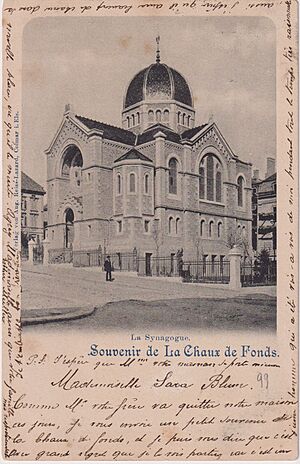
In the late 1700s, Swiss watchmaking became very popular. At the same time, Jewish traders began to settle in the region. They became involved in the watch industry. After 1848, rules about where Jewish people could live were slowly removed in the Canton of Neuchâtel.
In the 1870s, Swiss watchmaking faced a challenge. American companies started making watches and parts in factories. The old way of individual craftspeople could not keep up. But from the 1880s, the Swiss watch industry slowly became more modern.
One of the first modern factories was started by the Ditesheim brothers. They moved to La Chaux-de-Fonds in 1876. Many Jewish manufacturers were open to new ideas. They invested in modern ways of making watches. The Ditesheim company became famous worldwide and was renamed ‘Movado’ in 1905.
As the economy grew, more people moved to the city, including many Jewish families. By 1912, about 30% of the city's 180 medium-sized family businesses were owned by Jewish families. The Jewish community grew from 541 to 900 members in about 20 years.
During World War I, watch companies made things for the war, like parts for artillery shells. After the war, these orders stopped. Before World War II, Jewish watch producers faced difficulties. Their contacts in other countries were being persecuted. Some Jewish companies in La Chaux-de-Fonds were even watched by German spies. They were suspected of sending war materials to the Allied Forces.
Where is La Chaux-de-Fonds? Geography and Landscape
La Chaux-de-Fonds covers an area of about 55.7 square kilometers (21.5 square miles). Over half of this land (54.7%) is used for farming. About 27.9% is covered by forests.
The city itself, with its buildings and roads, makes up 16.7% of the land. A small part (0.5%) is rivers or lakes. Very little land (0.2%) is unproductive.
The city is located in the Jura Mountains, near the French border. It sits at an elevation of about 1,000 meters (3,280 feet).
City Symbol: The Coat of Arms
The city's coat of arms has a special design. It is divided into three horizontal parts. The top part is blue with three silver five-pointed stars. The middle part is silver with a golden beehive surrounded by seven golden bees. The bottom part has a checkerboard pattern of silver and blue squares.
Who Lives Here? Demographics
La Chaux-de-Fonds has a population of about 38,694 people. In 2008, about 29.1% of the people living here were foreign nationals. Over the last ten years (2000–2010), the population grew by 1.3%.
Most people (85.5%) speak French as their main language. Italian is the second most common (3.6%), followed by Portuguese (3.2%). A smaller number of people speak German (900) or Romansh (32).
In 2008, 48.0% of the population was male and 52.0% was female. Many people (41.0%) were born in La Chaux-de-Fonds. About 26.1% were born outside Switzerland.
Children and teenagers (0–19 years old) make up 22.5% of the population. Adults (20–64 years old) make up 58.9%. Seniors (over 64 years old) make up 18.6%.
In 2000, there were 17,207 households in the city. On average, there were 2.1 people per household. Many households (7,087) had only one person.
Population Over Time: Historical Data
The following chart shows how the population of La Chaux-de-Fonds has changed over the years:
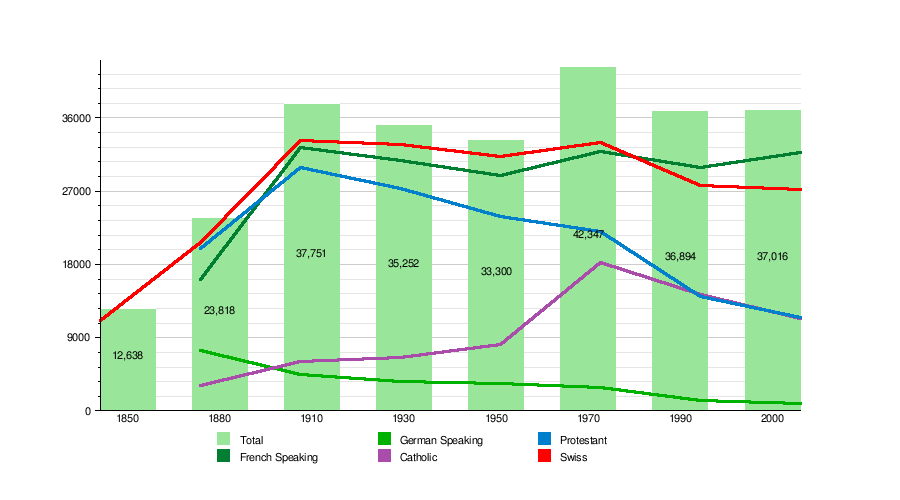
| Historical Population Data | |||||||||||
|---|---|---|---|---|---|---|---|---|---|---|---|
| Year | Total Population | French Speaking | German Speaking | Catholic | Protestant | Other | Swiss | Non-Swiss | |||
| 1850 | 12,638 | 11,084 | 1,554 | ||||||||
| 1880 | 23,818 | 16,089 | 7,421 | 3,160 | 20,006 | 45 | 20,681 | 3,137 | |||
| 1910 | 37,751 | 32,363 | 4,383 | 6,077 | 29,914 | 94 | 33,218 | 4,533 | |||
| 1930 | 35,252 | 30,761 | 3,559 | 6,519 | 27,306 | 131 | 32,644 | 2,608 | |||
| 1950 | 33,300 | 28,818 | 3,305 | 8,100 | 23,877 | 127 | 31,265 | 2,035 | |||
| 1970 | 42,347 | 31,762 | 2,903 | 18,142 | 21,979 | 2,002 | 32,922 | 9,425 | |||
| 1990 | 36,894 | 29,873 | 1,191 | 14,379 | 13,963 | 3,829 | 27,689 | 9,205 | |||
| 2000 | 37,016 | 31,653 | 900 | 11,320 | 11,425 | 3,128 | 27,106 | 9,910 | |||
Important Buildings: Heritage Sites
La Chaux-de-Fonds has 23 buildings and sites that are very important to Switzerland's history and culture. These are called heritage sites of national significance. The UNESCO World Heritage Site of La Chaux-de-Fonds / Le Locle is also included.
Some of these important places are:
- Libraries, Museums, and Theaters:
- The City Library of La Chaux-de-Fonds (Bibliothèque de la Ville).
- The Museum of Fine Arts (Musée des beaux-arts).
- The Natural History Museum (Musée d‘histoire naturelle).
- The International Museum of Watchmaking (Musée international d’horlogerie).
- The Theater and Music Hall (Théâtre et Salle de musique).
- Religious Building:
- The Synagogue on Rue du Parc 63.
- Farms:
- Ferme des Brandt at Les Petites-Corsettes 6.
- Ferme Haute Fie and Maison Carrée at Le Valanvron 9.
- Ferme les Crêtets on Rue des Crêtets 148.
- Companies:
- Spillmann SA on Rue du Doubs 32.
- The Electric Plant (Usine électrique) at Rue Numa-Droz 174.
- Houses:
- Villa Anatole Schwob on Rue du Doubs 167.
- Villa Fallet on Chemin de Pouillerel 1.
- Villa Gallet on Rue David-Pierre-Bourquin 55.
- Villa Jaquemet on Chemin de Pouillerel 8.
- Villa Stotzer on Chemin de Pouillerel 6.
- Maison Blanche at Chemin de Pouillerel 12.
- Other Buildings:
- The slaughterhouse (Abattoirs) on Rue du Commerce 120–126.
- The Ancien Manège (a collective house from 1968).
- The crematorium on Rue de la Charrière.
- The Domaine des Arbres.
- The Grande Fontaine on Avenue Léopold-Robert.
- The Loge l’Amitié.
How the City Works: Economy
In 2010, the unemployment rate in La Chaux-de-Fonds was 8.2%.
In 2008, about 260 people worked in the primary economic sector. This includes jobs like farming and forestry. There were about 95 businesses in this sector.
About 10,594 people worked in the secondary sector. This includes manufacturing and construction. There were 550 businesses in this sector.
In the tertiary sector, which includes services, 11,813 people were employed. There were 1,290 businesses in this sector. Overall, 17,870 people in the city had jobs. Women made up 46.1% of the workers.
In 2008, there were 19,692 full-time jobs. Most of these (9,063) were in manufacturing. About 903 jobs were in construction. In the service sector, many jobs were in sales (2,287), transportation (680), hotels and restaurants (571), and healthcare (2,078).
In 2000, 8,916 workers came into the city for work. At the same time, 3,481 workers left the city to work elsewhere. This means more people come to La Chaux-de-Fonds for jobs than leave it. About 21.4% of workers used public transport, and 52.8% used a private car.
Beliefs and Communities: Religion
Religion in La Chaux-de-Fonds, 31.12.2014 Roman Catholic (43.4%) Protestant (27.1%) Other Christian (1.2%) Jewish (0.3%) Islam (7.8%) Other Religion (3.2%) Undeclared (1.9%) Unaffiliated (15.1%)
According to the 2000 census, about 30.6% of the city's people were Roman Catholic. Another 27.7% belonged to the Swiss Reformed Church (a type of Protestant church).
Smaller groups included members of an Eastern Orthodox Church (0.55%), the Christian Catholic Church of Switzerland (0.81%), and other Christian churches (6.39%).
There were also people who were Jewish (0.35%) and Muslims (3.70%). A small number of people were Buddhist, Hindu, or belonged to other faiths.
About 27.17% of the population did not belong to any church. This group included people who were agnostic or atheist. About 5.30% of the people did not answer the question about their religion.
Learning and Schools: Education
In La Chaux-de-Fonds, about 33.4% of the population has finished high school. About 10.7% have gone on to higher education, like a university or a specialized college.
In the canton of Neuchâtel, most towns offer two years of optional kindergarten. This is followed by five years of required primary school. After that, there are four years of required secondary school. Many students travel to larger schools for secondary education.
During the 2010–11 school year, La Chaux-de-Fonds had 38 kindergarten classes with 728 students. There were also 113 primary classes with 2,042 students.
In 2000, 754 students came to La Chaux-de-Fonds from other towns for school. At the same time, 644 residents went to schools outside the city.
La Chaux-de-Fonds has two libraries: the Bibliothèque de la Ville and the Haute école Arc – Arts appliqués. In 2008, these libraries had over 670,000 books and other media. They loaned out over 342,000 items that year.
Arts and Traditions: Culture
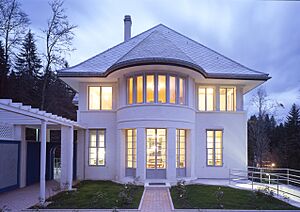
La Chaux-de-Fonds is home to the Musée International d'Horlogerie (International Museum of Watchmaking). This museum was built with money from the Gallet watchmaking family in 1899. It is an important place to learn about the history of timekeeping.
The Art Nouveau style greatly influenced the city's buildings and culture in the late 1800s.
The daily newspaper L'Impartial has been published in La Chaux-de-Fonds since 1880.
The city received the Wakker Prize in 1994. This award recognizes cities that have done a great job preserving their architectural heritage.
Sports Teams in La Chaux-de-Fonds
La Chaux-de-Fonds has a professional ice hockey team called HC La Chaux-de-Fonds. They play in the Swiss League (SL), which is the second-highest league in Switzerland. Their home ice is the Patinoire des Mélèzes, which can hold 7,200 fans. The team was very successful from 1968 to 1973, winning the championship six times in a row.
The city also has an amateur football (soccer) team, FC La Chaux-de-Fonds.
Getting Around: Transport
The city is a hub for four different railway lines. It has six railway stations within its borders. The main station is La Chaux-de-Fonds. Other stations include La Cibourg, La Chaux-de-Fonds-Est, La Chaux-de-Fonds-Grenier, Le Reymond, and Le Crêt-du-Locle.
La Chaux-de-Fonds also has its own airport, Les Eplatures Airport. The city uses a trolleybus system for public transport.
Weather in La Chaux-de-Fonds: Climate
| Climate data for La Chaux-de-Fonds (1991–2020) | |||||||||||||
|---|---|---|---|---|---|---|---|---|---|---|---|---|---|
| Month | Jan | Feb | Mar | Apr | May | Jun | Jul | Aug | Sep | Oct | Nov | Dec | Year |
| Mean daily maximum °C (°F) | 3.0 (37.4) |
3.6 (38.5) |
7.1 (44.8) |
11.0 (51.8) |
15.0 (59.0) |
18.9 (66.0) |
20.8 (69.4) |
20.7 (69.3) |
16.6 (61.9) |
12.8 (55.0) |
7.2 (45.0) |
3.8 (38.8) |
11.7 (53.1) |
| Daily mean °C (°F) | −1.0 (30.2) |
−0.7 (30.7) |
2.6 (36.7) |
6.1 (43.0) |
10.2 (50.4) |
13.8 (56.8) |
15.6 (60.1) |
15.4 (59.7) |
11.5 (52.7) |
8.0 (46.4) |
3.1 (37.6) |
−0.1 (31.8) |
7.0 (44.6) |
| Mean daily minimum °C (°F) | −5.4 (22.3) |
−5.4 (22.3) |
−2.1 (28.2) |
1.1 (34.0) |
4.9 (40.8) |
8.5 (47.3) |
10.2 (50.4) |
9.9 (49.8) |
6.7 (44.1) |
3.4 (38.1) |
−1.1 (30.0) |
−4.1 (24.6) |
2.2 (36.0) |
| Average precipitation mm (inches) | 107 (4.2) |
93 (3.7) |
99 (3.9) |
96 (3.8) |
131 (5.2) |
119 (4.7) |
131 (5.2) |
131 (5.2) |
114 (4.5) |
117 (4.6) |
118 (4.6) |
132 (5.2) |
1,389 (54.7) |
| Average snowfall cm (inches) | 54 (21) |
61 (24) |
36 (14) |
13 (5.1) |
1 (0.4) |
0 (0) |
0 (0) |
0 (0) |
0 (0) |
3 (1.2) |
29 (11) |
56 (22) |
253 (100) |
| Average precipitation days (≥ 1.0 mm) | 12.3 | 11.5 | 11.4 | 11.7 | 14.4 | 12.8 | 12.5 | 11.6 | 10.4 | 12.3 | 11.9 | 13.6 | 146.4 |
| Average snowy days (≥ 1.0 cm) | 8.9 | 9.6 | 6.4 | 2.6 | 0.2 | 0.0 | 0.0 | 0.0 | 0.0 | 0.5 | 5.1 | 9.2 | 42.5 |
| Average relative humidity (%) | 82 | 79 | 75 | 73 | 75 | 75 | 74 | 76 | 80 | 81 | 82 | 83 | 78 |
| Mean monthly sunshine hours | 95 | 106 | 144 | 160 | 171 | 192 | 215 | 205 | 160 | 134 | 93 | 80 | 1,754 |
| Percent possible sunshine | 38 | 40 | 42 | 43 | 40 | 45 | 50 | 52 | 47 | 44 | 37 | 35 | 44 |
| Source: MeteoSwiss | |||||||||||||
In July 2023, La Chaux-de-Fonds had a very strong storm. One person died and about 40 people were hurt. The storm had powerful winds that reached speeds of up to 217 kilometers per hour (135 mph).
The storm caused a lot of damage to the city. It tore roofs off buildings and knocked down trees. Thousands of buildings and cars were affected. Experts think the strong winds were caused by a downburst. This is a weather event where a sudden cool air current rushes down from a thunderstorm.
Famous People from La Chaux-de-Fonds
Many notable people were born or lived in La Chaux-de-Fonds.
Important People from the 1700s
- Pierre Jaquet-Droz (1721–1790), a skilled watchmaker and machine designer.
- Louis Léopold Robert (1794–1835), a famous painter.
Important People from the 1800s
- Numa Droz (1844–1899), a politician who served as President of the Swiss Confederation.
- Louis Chevrolet (1878–1941), a race car driver who helped start the Chevrolet car company in the US.
- Le Corbusier (1887–1965), a Swiss-French architect and a pioneer of modern architecture.
- Blaise Cendrars (1887–1961), a well-known poet and novelist.
Important People from the 1900s
- Adrienne von Speyr (1902–1967), a Swiss Catholic doctor and writer.
- Pierre Graber (1908–2003), a politician who was a member of the Swiss Federal Council.
- Anne-Lise Grobéty (1949–2010), a Swiss journalist and author.
- Magali Messmer (born 1971), a professional triathlete who won a bronze medal at the 2008 Summer Olympics.
Famous Watch Companies from La Chaux-de-Fonds
Many well-known watch companies began in La Chaux-de-Fonds:
- Arnold & Son, started in 1764.
- Ball Watch Company, founded by Webb C. Ball.
- Corum.
- Cyma Watches, started in 1862.
- Ebel, founded by Eugene Blum and Alice Levy in 1911.
- Eberhard & Co., started by George-Emile Eberhard in 1887.
- Gallet & Co., founded by Julien Gallet in 1826.
- Girard-Perregaux, started by Constantin Girard and Marie Perregaux in 1856.
- Heuer Leonidas, now known as TAG Heuer, started by Edouard Heuer in 1860.
- Invicta Watch Group, founded by Raphael Picard in 1837.
- Movado, started by Achilles Ditesheim in 1881.
- Omega SA, founded in 1848.
- Rolex trademark, registered by Hans Wilsdorf in 1908.
- Rotary, started by Moise Dreyfuss in 1895.
- Solvil et Titus, started by Paul Ditisheim in 1892.
- Vulcain by Maurice Ditisheim in 1858.
Sister City: Twin Town
La Chaux-de-Fonds has a twin town relationship with:
Images for kids
See also
 In Spanish: La Chaux-de-Fonds para niños
In Spanish: La Chaux-de-Fonds para niños




